#shabnam case story
Explore tagged Tumblr posts
Text
How to Become an Aromatherapy Practitioner

Aromatherapy is a holistic healing practice that harnesses the therapeutic benefits of essential oils to enhance physical, mental, and emotional well-being. As people increasingly turn to natural remedies and wellness practices, the demand for qualified aromatherapy practitioners continues to grow. If you’re passionate about holistic healing and want to explore this rewarding field, here’s a comprehensive guide to becoming an aromatherapy practitioner.
1. Understand Aromatherapy
Before embarking on this journey, take the time to understand what aromatherapy entails. This practice involves using plant-derived essential oils to promote relaxation, alleviate stress, improve mood, and support overall health. Research the history, principles, and benefits of aromatherapy to ensure it aligns with your interests and values.
2. Gain Knowledge of Essential Oils
A solid understanding of essential oils is crucial for any aspiring aromatherapy practitioner. Learn about the different types of essential oils, their properties, and their uses. Familiarize yourself with safety guidelines, such as dilution rates and contraindications, to ensure you use these potent substances responsibly.
3. Enroll in an Accredited Aromatherapy Program
Formal education is essential to gain the expertise and credentials needed to practice professionally. Look for an accredited aromatherapy course that offers a well-rounded curriculum, including:
Essential oil chemistry
Anatomy and physiology
Blending techniques
Client consultation and care
Organizations such as the National Association for Holistic Aromatherapy (NAHA) or the International Federation of Aromatherapists (IFA) often provide lists of approved programs.
4. Hands-On Practice
Practical experience is vital for developing confidence and competence. Most training programs include hands-on workshops and case studies, allowing you to practice blending oils and working with clients under supervision.
5. Obtain Certification
After completing your training, you may need to pass an exam to obtain certification. Certification demonstrates your credibility and commitment to professional standards. It also increases your chances of attracting clients and opportunities.
6. Develop Your Professional Skills
In addition to technical knowledge, successful practitioners need strong communication and interpersonal skills. Building trust and understanding your clients’ needs are integral to providing effective aromatherapy treatments.
7. Set Up Your Practice
Decide whether you want to work independently or join an established wellness center. If you’re starting your own practice, consider:
Registering your business
Creating a professional website
Building a comfortable and inviting treatment space
Networking with other professionals in the wellness industry can also help you grow your practice.
8. Stay Updated and Continue Learning
Aromatherapy is an evolving field, with ongoing research revealing new insights into the benefits and applications of essential oils. Attend workshops, conferences, and advanced courses to stay informed and expand your skill set.
9. Promote Your Services
Effective marketing is essential to attract clients. Use social media, blogs, and local events to showcase your expertise. Sharing testimonials and success stories can help build your reputation and credibility.
Final Thoughts
Becoming an aromatherapy practitioner is a fulfilling journey that combines science, creativity, and compassion. By investing in education, gaining practical experience, and staying dedicated to your craft, you can help others achieve balance and well-being through the power of essential oils.
Rupal Shabnam Tyagi is an advocate for holistic wellness and an experienced aromatherapy practitioner. She is passionate about empowering others to explore the transformative power of essential oils.
0 notes
Text
Divya Bharti changed her religion to marry Sajid. This is what happened to her actress right before she died!

Divya Bharti Special Story: Divya Bharti was one of the actresses of the Bollywood industry in the 90s, during which beauty discussions made headlines. This is why Divya Bharti became a well-known actress in the Bollywood industry after movies in a very short span of time. In his brief Bollywood career, he has worked with many of the titans of the industry. Despite starting her career at a very young age, Divya Bharti has made many films back to back in a short span of time. She was signed on to 14 films at the same time as well. Entering the Bollywood Industry with Govinda Divya Bharti debuted in the Bollywood industry in 1992 with the film Vishwatma. But let me say that previously she worked in her Divya's Telugu films where her beauty and innocence made her people admire her and her beauty and simplicity brought her to the Bollywood industry. Her first successful film for Divya Bharti was Shola Aur Shabnam opposite Govinda. This film made him an overnight star. Married at 18, died at 19 When Divya Bharti died on April 5, 1993, bidding farewell to the world at the young age of 19, she got married. In fact, at the age of 18, her Bollywood industry famous producer and director Sajid Nadiadwala married her. Divya not only got married at the age of 18. She converted to Islam for Sajid Nadiadwala and Divya became Sana Nadiadwala. What happened to Divya before she died? News of Divya Bharti's sudden death at the age of 19 shocked everyone. At the same time, after her death, it was widely reported that Divya started her drug addiction at a young age. However, his mother responded to these reports, saying she never did drugs. Yes, it is certainly true that he drank rum that day. For many years, the investigation into Divya Bharti's death continued, but there was no disclosure of any kind. So in 1998 the case was closed. Divya Bharti was returning to Mumbai from Chennai after finishing the shooting on the day of her death. He injured his leg during filming. Around 10pm, some friends came to his house on the 5th floor of the Tulsi Apartments in Versova, West Andheri, Mumbai. In the meantime, Divya Bharti was sitting and drinking with his friends. At that time Divya's maid was cooking her food in her kitchen and Divya was sitting by her window and directing her. Then Drunk Divya's hand slipped and fell straight from the window without a grill. He suffered many serious injuries in this accident. He was rushed to Kapoor Hospital, but died shortly after arriving in the emergency room. Sajid Nadiadwala remained in the circle of questions. After Divya's death, many serious allegations against Sajid Nadiadwala were also leveled. The investigation found nothing about Sajid Nadiadwala. Sajid Nadiadwala still loves Divya Bharti very much and this is why he still keeps Divya Bharti's picture in his wallet. Not only that, he considers Divya's family as his own family. ALSO READ- The two copies of Anupam Kher are his older brother Raju. Looking at the pictures, you will be fooled. If you don’t believe it DISCLAIMER We’ve taken all measures to insure that the information handed in this composition and on our social media platform is believable, vindicated and sourced from other Big media Houses. For any feedback or complaint, reach out to us at [email protected] Read the full article
0 notes
Text
पवन जल्लाद से भी खतरनाक था नाटा मल्लिक, फांसी की रस्सियों की ताबीज़ बना कर बेचता था
पवन जल्लाद से भी खतरनाक था नाटा मल्लिक, फांसी की रस्सियों की ताबीज़ बना कर बेचता था
लखनऊ: निर्भया के चार दोषियों को फांसी देने वाले पवन जल्लाद एक बार फिर चर्चा में आ गए. वजह है अमरोहा की शबनम. जी हां, प्रेम में अंधी होकर अपने ही परिवार के सात लोगों की बेरहमी से हत्या करने वाली शबनम को कभी भी फांसी हो सकती है. उसे सूली पर चढ़ाने की जिम्मेदारी मेरठ के पवन जल्लाद को दी गई है. वैसे तो भारत में फांसी की सजा ब्रिटिश काल के पहले से है. हालांकि रेयरेस्ट ऑफ द रेयर केस में फांसी की सजा…
View On WordPress
#Amroha murder case#Death Row Convict#Hangman Nata Malik#Jallad Nata Malik#muder convict shabnam#Nata Malik#nata malik used to sell locket made of hanging ropes#nata malik who used to sell locket made of hanging ropes#Pawan Jallad#Shabnam Ali#shabnam amroha#shabnam case story#Shabnam Hanging Case#shabnam hanging date#Shabnam Salim Case#shabnam son#Shabnam to be hanged#Story Of Nata Malik#Uttar Pradesh#who is shabnam#जल्लाद नाटा मल्लिक#पवन जल्लाद#फांसी की रस्सियों की ताबीज बना कर बेचता था#फांसी की रस्सी की ताबीज बनाकर बेचता था नाटा मल्लिक#शबनम#शबनम अमरोहा
0 notes
Text
LEVERAGE (PT 2)
A DEADLY CLASS ONE SHOT
— PAIRING: Marcus Lopez Arguello x Reader — WORD COUNT: 2,202 — WARNINGS: Cursing, violence, kidnapping — REQUESTED BY: N/A; literally one person commented that they wanted a part two and I already had it planned so- — A/N: So....... this got super long. Oops lol. I used some of the same dialogue from episode 10, but most of this deviates from the original source material which I did on purpose because it fit better for the sake of this story so please don’t come for me about not sticking to the “right” plot- Anyway, I had lots of fun writing this, and I hope you guys like it :)
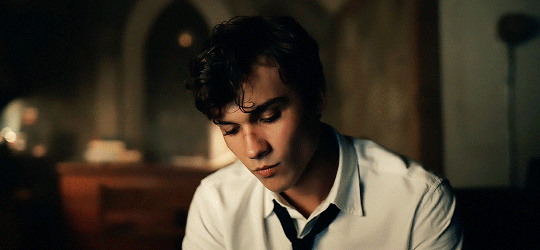
Marcus could’ve sworn he felt his heart drop straight out of his chest when he got back to the van and saw you weren’t there. It was the strangest thing—he’d snuck off as the fight inside Shabnam’s house died down with a weird feeling that he should go check on you, needed to make sure you were still okay. You’re just being paranoid, he’d told himself, but he had to follow his instincts, just to be sure. Instead of finding you safe and sound where he’d left you, however, you were nowhere in sight.
When Marcus got back to the sprawling mansion, his friends were regrouping on the bottom floor in the kitchen. “Has anyone seen Y/N?” he asked as soon as he was within earshot, not even bothering to keep his voice down.
As the rest of the group exchanged questioning glances, Billy sighed. “I told you not to bring them,” he said, but he started to get to his feet regardless as if to help search the house, but Marcus was quick to shut him down.
“No, you’re right,” Marcus agreed. “It was my idea, and it’s my fault we’re even in this mess. I can’t risk losing any of you, too. Go back to the van. I’ll catch up with you guys later.”
The calm facade he’d put up for his friends’ sake was gone as soon as they were. Running through the house, bat poised and prepared to strike down any redneck friend of Chester’s that dared to get in his way, Marcus was absolutely frantic. Each time he called your name and no answer returned, gruesome images flashed in his head of all the reasons that could’ve been the case, of all the things he’d endured at the hands of Chester in Sunset Boys’ Home, and while he wouldn’t wish those things on anyone—especially not you, of all people—he couldn’t help that his mind naturally wandered to where his worst fears lied in wait, ready to overtake him at the first sign of danger.
You’re being paranoid, he told himself. This is like Vegas all over again. They’re fine. They probably just—
In Marcus’s haste and clouded state of mind, he wasn’t paying attention to where he was going, and the sound of a cage door rattling cut off his internal monologue. “What the hell?” he muttered, fumbling in his pocket for his lighter. The room was dark, too dark to make out any specifics save for the vague outline of a figure squatting inside the small, metal prison. The flickering orange glow of the flame coming from the lighter in Marcus’s hand revealed his company—an old, angry woman in a pig costume snarled at him from behind the bars, and he couldn’t say he blamed her—he would’ve been pretty pissed, too, if Chester had dressed him up like an animal and caged him like one. It had been bad enough having had to share a room with him.
“Love him, my bull god!” the woman shouted abruptly. “Love him with your murder stick!”
She probably would’ve said more if it weren’t for the sudden bullet she received to the head. Marcus stumbled away in surprise, dropping his bat in the process. “What the fuck?” he said, ducking as he glanced around warily for the source of the deadly shot.
“A bat?” said Chester, stepping out of the shadows, gun in hand. “You watched the Warriors too many times, bud.”
And before Marcus knew what was happening, Chester overtook him like he had done so many times before.
The first thing Marcus noticed when he came to was the warmth. He opened his eyes, blinking in the bright light of the many bulbs that had been drilled into the makeshift sign that leaned against the wall beside him—Fuck Face, it read, in big, red lettering.
The next thing he noticed was the tape on his mouth.
Shit. He didn’t have time for this.
Marcus was vaguely aware of the old man from Shabnam’s party—the one who’d tried to correct him about what classified as a gravity bong—giving some sort of talk show introduction, but his attention was focused on where Chester stood behind the camera, now wearing a tacky blazer over his t-shirt and a manic grin on his mangled face. He seemed defenseless at the moment, and one look at Marcus’s unbound wrists told him that he could make a run for it, but he didn’t. It was too easy. Marcus had already underestimated Chester enough as it was, and he doubted he could live through making that same mistake again.
Instead, Marcus remained planted to his seat on the couch, but his eyes followed Chester as he moved to sit in front of the camera. Marcus saw Chester’s mouth move, he heard the music playing softly in the background, but it felt distant, like it was nothing more than a scene he was watching on a TV screen. It was as if he was a member of the live audience Chester was supposedly talking to through the camera lens, being forced to take part in the horrific game Chester was playing, and he couldn’t find the remote to change the channel to something better, something more pleasant where you were still safe with him.
“You’re gonna admit that you’re not the Orphanage Killer.”
That sentence alone was enough to bring Marcus back to the present. His dark eyes narrowed at Chester, whose smile faltered ever so slightly.
“And if you don’t,” he continued, “I might just have to take somethin’ of yours in return.”
Marcus’s brow furrowed. He didn’t want that to mean what he thought it did, but Chester turned to the man on the other end of the couch and said, “Why don’t you bring in our special guest, Mr. Shandy?”
The older man disappeared into a back room, and when he came back, he had you by the arm, leading you onto the shoddy set that Chester had put together for his talk show. You caught Marcus’s gaze as you were prodded toward the vacant sofa cushion beside him, silently pleading for help.
And Marcus wanted to help you, but for the first time in his life, the only thing he could think of was the consequences. He was scared, scared of losing you, but even more so of being the one responsible. He’d never be able to forgive himself if you suffered because of something stupid and reckless he’d done as some poor attempt to be the hero yet again. He was already the reason you were in this mess at all, and he couldn’t risk dragging you down any further into the hole he’d dug for himself. So, Marcus sat, watching quietly as you were placed next to him, unable to meet your tear-stained face.
“I found this pretty, little thing out in the yard,” explained Chester, “and I was about to kill them for seeing too much when I realized something. After your fireworks display, I needed to get back the upper hand. I needed some leverage. You’re too much of a good guy, Marcus, always tryin’ to save everyone, so I knew you’d come runnin’ straight to me once you found out they were gone. It was only a matter of time.” He paused, letting his words sink in, his gruesome grin returning. “So, either you give me what I want, or I’ll hurt you the way you hurt me. An eye for an eye and all that.”
You glanced nervously at Marcus, but he stared straight ahead, his jaw set and gaze hardening.
Chester waved a hand at Shandy, who reached across you to rip the tape from Marcus’s mouth. Marcus winced, but he didn’t make a sound save for the quiet exhale of breath that escaped past his lips. He was eerily calm, and you hated it. While you were moments away from yet another breakdown, he was just as stoically unreadable as ever.
Swallowing, Marcus, at last, said, “Chester killed all those people.”
Chester leaned forward in his seat. “Because?”
Marcus’s eyes darted over to you, then back at Chester. Why was Chester dragging this out? It was supposed to be simple—give Chester the credit he thought he deserved, and maybe you’d have the chance to walk away unharmed—mostly, anyway, though being held hostage in a stranger’s basement is bound to have lasting psychological effects. Marcus wasn’t so sure about himself—knowing Chester, he’d want to exact some sick sort of revenge—but he didn’t care about himself anymore. Your safety was all that mattered, but Chester seemed no closer to letting you go now than he did when you were first brought in. Marcus needed to buy more time. No, said the voice at the back of his head. You need a plan, dumbass.
So, Marcus did what he did best: he improvised. He was no stranger to talking his way out of dangerous situations, so what was one more? “B-because,” he started, his gaze drifting through the room as if he was going to find the words he needed scratched into the walls or hanging off of the ceiling.
Chester again leaned forward, this time so far you were sure he’d fall out of his chair. He gave Marcus his undivided attention, eagerly waiting for the next sentence to fall out of your boyfriend’s mouth.
“He’s desperate for some semblance of significance in the world,” Marcus continued, “to make a mark even if it is just a smear shit stain.”
What the hell? you thought, your irritation growing by the minute. You weren’t sure how kidnapping worked—this was only your first time playing the victim—but you were almost certain you were supposed to appeal to your enemy’s better nature. Tell them what they wanted to hear, and maybe they’d have mercy.
Marcus knew better, though. Chester wasn’t capable of mercy. All he knew was anger, an anger that, if fueled enough, could become blinding. Marcus was well-acquainted with that fiery rage—the scar on his face was a testament to that—and if he could redirect it onto himself, he could act as a shield for you.
Chester’s face fell, an eye twitching.
“Because he can’t make anything, so he destroys,” Marcus said, pressing on. “Because he’s the kind of guy who’d screw a goat on national television if it got people to pay attention.”
You wanted to scream at Marcus to stop, to tell him that he was only making things worse, but the tape on your mouth and the sheer fear of what would happen if you took it off prevented you from doing so.
“He doesn’t need a camera to do that.”
The focus of the room’s inhabitants shifted onto Dwight Shandy. There was a pause, the only noise filling the sudden void being his misplaced laughter, before Chester bolted upright, grabbed the gun off the corner of his desk, and lunged at Shandy.
“You hypocrite!” yelled Chester.
Maybe Marcus should’ve been thanking Dwight Shandy for drawing the attention onto himself and being the ultimate recipient of Chester’s rage, causing enough of a distraction for the Nicaraguan to grab your hand and drag you off the couch, but there was no time. Marcus led you aimlessly through the bottom level of the house, unsure from which direction he’d come but absolutely certain that he had to get you as far away from Chester as possible.
“I ain’t finished with you, boy!” Chester yelled, his voice echoing down the hallway after you as you ran. Marcus squeezed your hand tighter, pulling you to the side abruptly and into an alcove just out of sight. The space was small, and despite Marcus’s somewhat composed performance on set, you could feel his heartbeat hammering against you now, his breathing ragged as he held you close, doing his best to block you.
Soon after, Chester ambled past, unaware of your hiding spot. Carefully, Marcus crept out after him, much to your dismay.
The room was too dimly lit for you to see anything more than the faint outline of the two boys as they fought just on the other side of a tall shelving unit. One of them got thrown to the ground—Marcus, you assumed, if Chester’s bragging was any indication—as the other hovered over him, landing punch after punch. Eventually, you had to turn away, snapping your eyes shut as you forced down the taste of bile in your throat.
There was a metal clang, followed by the screech of a latch as a cage door opened, and the angry dog within was set free. Claws scrabbled against concrete, teeth snapping, and a set of hands grabbed you by the shoulders. You nearly jumped out of your skin as you cautiously opened your eyes only to see Marcus, now covered in blood, staring down at you. He gently grabbed a corner of the tape covering your mouth, his expression apologetic as he peeled it off.
You sighed in relief, collapsing into Marcus’s arms. “Is this what they teach you at that school?” you choked out, another round of tears already beginning to soak your boyfriend’s t-shirt.
Marcus buried his face in your hair. “You have no idea.”
#marcus lopez arguello x reader#marcus lopez arguello one shot#marcus lopez arguello#marcus lopez x reader#marcus lopez one shot#marcus lopez#deadly class x reader#deadly class one shot#deadly class
454 notes
·
View notes
Text
Temporary Marriage or Legal Prostitution?
Shabnam Barati
My quest started by questioning the reason behind the stigma around a legally and religiously accepted institute and its great impact on even foreigners’ perception of temporary marriage as legal prostitution. My resources were less than 15 movies produced after the revolution, two documentaries on YouTube, and a few academic papers which the latest dates back to 2012. Firstly, we need to know briefly about different types of marriages in Iran.

Legal marriages: Permanent and Temporary
The Islamic Republic of Iran recognizes two types of marriage: permanent or Nikah, and temporary or Sigheh. To be valid, temporary marriages need to have the legal form of the contract. However, this permission is given to the couple to contract this marriage verbally and just between the two of them as it doesn’t need witnesses nor to be registered, in contrast to the permanent marriage. In a temporary marriage, the duration should be precisely determined and can vary from one hour to 99 years. In Mut’a marriage, a consideration should be specified to be paid to the wife which is the equivalent of Mahr in permanent marriage, only less. Besides this, a man doesn’t have to provide financial support for his temporary wife, a right reserved to a permanent wife. And last but not least, a man is allowed to make four permanent marriage contracts and as many temporary ones as he desires, while a woman can only have one husband of any type at a time (Ghodsi, 1994).
Temporary marriage in Iran’s cinema after 1979
If one watches one or two of the movies about this topic, the rest of the list is not any different except for the names and some other details. The plot of these movies is about a man who has a family and a secret temporary wife who’s usually younger and married to him because of either love or financial needs (in the latter case, she’s probably a widow or divorcee). After a set of events, the secret is revealed, and the family becomes about to fall apart. In the end, either the regretful man can save his family or is left alone because his temporary wife also becomes penitent and leaves him. Nothing good comes out of these marriages in any of these movies.
I recall when one of these movies became so controversial as it was -or the first time- about the custody of a child who was born in a temporary marriage. Islamic law reserves equal rights for the children of permanent and temporary marriage, but to be recognized by the father is completely another story.
In the bazaar of sexes: legal prostitution in Iran
In the bazaar of sexes is a portrait of a bachelor who wavers between the fear of relationships and a longing for love, a divorced woman fighting for survival, and a man of faith who tries to reconcile the lived sexuality of others with his dogmas around the institution of temporary marriage (W-Film, N. D.). Sudabeh Mortezai looks at the Shi’i Iranian sexual and gender politics in the lower class part of the society. Mortezai openly shows all the struggles and dichotomies in Iran’s society caused by the neverending clash of modernity and religion that has led to the opposition between the people and the state.
youtube
Law of Desire: Temporary Marriage in Shi’i Iran
Shahla Haeri’s Law of Desire is the most comprehensive academic publication on the topic of Temporary marriage in Iran, which is based on her fieldwork back in 1989. In her book, I could find the reason for the stigma around Sigheh and its association with prostitution. Haeri highlights the taboo of women’s sexuality which is not something formed after the revolution. She claims that the mandatory unveiling by Reza Shah in 1936 followed by a more liberal approach of his son allowing women to dress as they wanted, led to the increase of unveiled women and consequently their representation in the media. However, there was hardly any debate about their sexuality. Pahlavis considered temporary marriage an archaic aspect of the religion and tried to push it to the margins of society (Haeri, 1981). Although the religious framework of the country didn’t let them outlaw the temporary marriage, their silence on the topic in general discourses and even in the Family Protection Law (1967) made the public believe it was prohibited (Haeri, 1981). Having lost its respectability, Zawaj Mut’a became a matter of secrecy, and the people who resorted to it started to hide it from their family and friends. As a result, the specifics of the institutions became ambiguous (Haeri, 1981).
As Haeri (1981) demonstrates, when the Islamic regime took over, they started trying to revive the temporary marriage to remove its negative connotations and reintroduce it from a new perspective. Identifying prostitution as a challenge to social order and the sanctioned rules for the association of the sexes, Shi’i scholars distinguish it from temporary marriage and believe that the latter is a divine way to satisfy a very natural need according to the social and religious rules (Haeri, 1981).
The majority of society doesn’t grant legitimacy to temporary marriage. Most middle-class women don’t acknowledge it as the recognition of women’s sexuality and active role in initiating a relationship; they see it as a threat to their marriages Haeri, 1981).
Haeri states that even though temporary marriage is still stigmatized and marginal, there are widowed or divorced women, utterly from the less favorable socioeconomic background, who make contracts of temporary marriage as it brings them financial support and a better status in society. Drawn upon her interviews, Haeri (1981) argues that these women are aware of their sexual appeal to men, initiate relationships, and some perceive temporary marriage as an “escape”.
References
Abu-Lughod, L. (2002). Do Muslim Women Really Need Saving? Anthropological Reflections on Cultural Relativism and Its Others. American Anthropologist, 104(3), 783–790. http://www.jstor.org/stable/3567256
Ghodsi, T. F. (1994). Tying slipknot: Temporary marriages in iran. Michigan Journal of International Law, 15(2), 645-686.
Haeri, S. (1992). Temporary Marriage and the State in Iran: An Islamic Discourse on Female Sexuality. Social Research, 59(1), 201–223. http://www.jstor.org/stable/40970689
0 notes
Text
9 Surprising Mysterious Deaths in Bollywood which is still Unsolved
Bollywood Death mysteries:
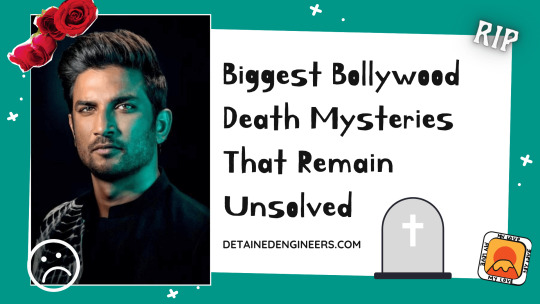
There are numerous Bollywood famous people who stunned the whole Nation with their Deaths. Everything, regardless of whether it is fortunate or unfortunate, is examined profoundly them. In this article, there is a rundown of Top 9 famous people that are considered to go through the baffling passing of Bollywood. The things are as yet unanswered in some cases that were a Bollywood entertainer’s homicide or veritable self-destruction. Here are nine Bollywood superstars who passed on in a strange situation.
So here are some of the mysterious deaths in Bollywood:
Sushant Singh Rajput

Sushant Singh Rajput was an Indian entertainer who was notable for his economically fruitful Bollywood movies like M.S. Dhoni: the untold story, Kedarnath, Chhichore, and so on. He was brought into the world on 21, January 1986, Patna. He appeared on Forbes India’s celebrity 100 lists twice since 2017. He was also considered as an inspiration for the youth.
He was discovered dead on the 14th of June, 2020, in his residence in Bandra, Mumbai, hanging from the ceiling fan. He died at the youthful age of 34. It is being said that he was experiencing major mental issues and was in sorrow. The world is still in shock about the news. There were a few imprints on his body that showed that he had not been dead ordinary.
He also had some marks on his neck, indicating that he had been coerced and had a rope dragged around his neck. Still, the police declared it a suicide and now the case is still going on but public thinks that it is the mysterious deaths in Bollywood. This is an extremely stunning strange demise in Bollywood. You can also read suicide or murder – star was lost
Sridevi

Sridevi, the recipient of the Filmfare Award, is known for her several hit films like Judaai, Mom, English Vinglish, and plenty of more. She was a great actress born on 13 August 1963, who was known for her acting skills. She was one of the best and most influential actresses within the history of Indian cinema additionally as “First Female Superstar”. Her mysterious death left everyone shocked.
On February 24, 2018, she passed away at the age of 54. The reason for her death was said to be a cardiac arrest. The incident happened in Dubai during a hotel where she slid along with her family to attend her nephew Mohit Marwah’s wedding. Sridevi died due to the “accidental drowning” in her hotel bathtub after losing consciousness, according to Dubai police. Her death was considered as to be one of the foremost mysterious deaths in Bollywood.
Jiah Khan

Jiah Khan was a British American 25- years old actress who was well known for her films like Nishabd with Amitabh Bachchan which was her debut film. She also appeared in films like Ghajini and Housefull. She ended her life on June 3, 2013, in Mumbai. She hung herself in her apartment roof fan.
On June 7, 2013, a six-page suicide note was found by her sister where she directly accused actor Suraj Pancholi, son of actors Aditya Pancholi and Zarina Wahab, whom she was dating at that point. On August 1, 2016, the CBI declared the cause of her death as ‘suicide by hanging’.
Her mother alleged that it was a murder and not suicide, but no victims were found or disclosed. The case was closed and buried under the name of murder and still, it’s a question if that was a suicide or not and her death is still considered as one of the most unsolved deaths in Bollywood.
Divya Bharti
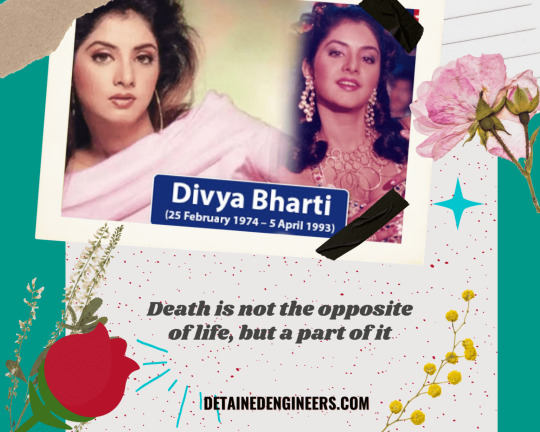
Divya Bharti was one of the gorgeous actresses who made her Bollywood debut with the action thriller Vishwathma. She is best known for her films in Shola Aur Shabnam and Deewana. She got married to Sajid Nadiadwala at the early age of 18.
She died in April 1993, after she fell from the fifth floor of the balcony of her Tulsi apartment in Mumbai. There were rumors that she was intoxicated at a party after which she went to her balcony and lost her grip and fell. There were also reports that a fair amount of alcohol was found in her blood. It was believed that the cause of her death was heavy internal bleeding at the back of her head.
There were also rumors that the actress was intoxicated at the party which resulted in her death. There were many speculations that pointed her death towards a murder but the case was closed in 1998 and the final reason was stated as an accidental death but her death is one of the most mysterious deaths in Bollywood.
Parveen Babi
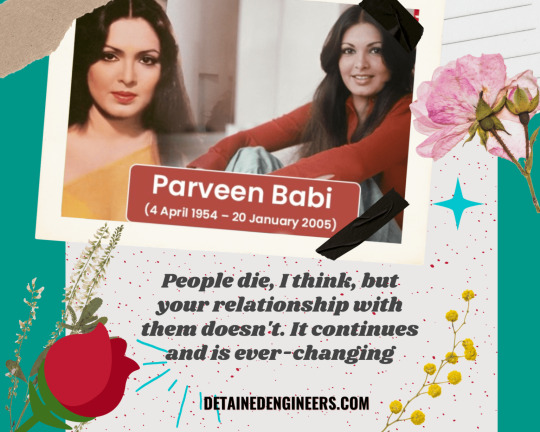
Parveen Babi was considered the most popular actress of Bollywood during the period of 70s and 80s. She was considered a glamorous fashion icon throughout her career. She starred in Blockbusters such as Deewar, Namak Halaal, Amar Akbar Anthony, and so on. She was the first actress to grace the cover of a magazine named Time Magazine in 1976.
She was being rumored to have diagnosed with paranoid schizophrenia and was found hanging at her house in Mumbai in January 2005. Her body was found after three days of death and post-mortem reports suggested she died due to organ failures and diabetes. But people thought that it was the mysterious deaths in Bollywood.
Guru Dutt
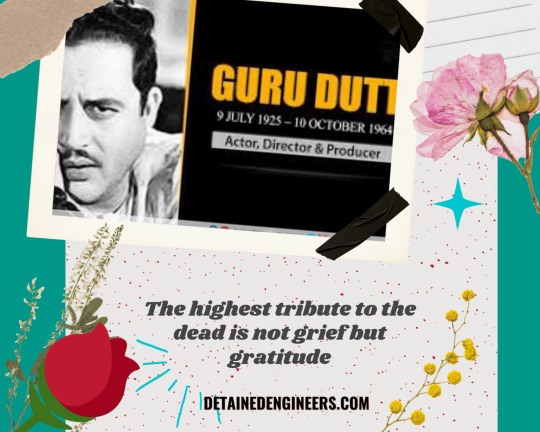
Vasanth Kumar Shivshankar Padukone also known as Guru Dutt was a famous Indian actor, producer, and also director who was known for his classic films such as Saheb Biwi Aur Gulam, Pyaasa, Kagaz Ke Phool, and numerous others. There is No talk on Indian cinema, which is complete without the mention of Guru Dutt.
On 10, October 1964, this unbelievable entertainer was discovered dead in his leased apartment at Pedder Road in Mumbai. He passed on at the early age of 39. There were rumors that he had a very turbulent married life due to which he was taking alcohol and sleeping pills together after being separated from his wife. Many speculations were made, whether it was a suicide attempt or an accidental overdose. But his death is still a mysterious deaths in Bollywood.
Nafisa Joseph

Nafisa Joseph was an Indian model and video jockey, beauty queen turned into Bollywood actress. She was the victor of Femina Miss India Universe 1997 and furthermore a finalist in the Miss Universe 1997 pageant in Miami Beach. She hanged herself to death in her Versova apartment on 29th July 2004. She died at the age of 26. It is accepted that she was experiencing sadness furthermore, she took her life not long before her marriage.
She was supposed to get married to automobile businessman Gautam Khanduja but her marriage was called off. Nafisa apparently suffered from depression because of the marriage that made her end her life. Nafisa Deaths is the mysterious deaths in Bollywood. Notwithstanding, her passing stayed at the center of attention whether it was a homicide or self-destruction.
Asif Basra

Asif Basra was an Indian entertainer, most popular to Western crowds for his job in Outsourced. Asif has also appeared in many Bollywood films including Once Upon a Time in Mumbai, Jab We Met, and Kai Po Che.
He has starred in many plays in India and abroad, performing in English, Hindi, and Urdu theatre productions. On 12 November 2020, he was found dead. The entertainer supposedly passed on by self-destruction at a private visitor house in McLeod Ganj, Himachal Pradesh. His mysterious deaths in Bollywood left the whole Bollywood industry in shock.
Manmohan Desai
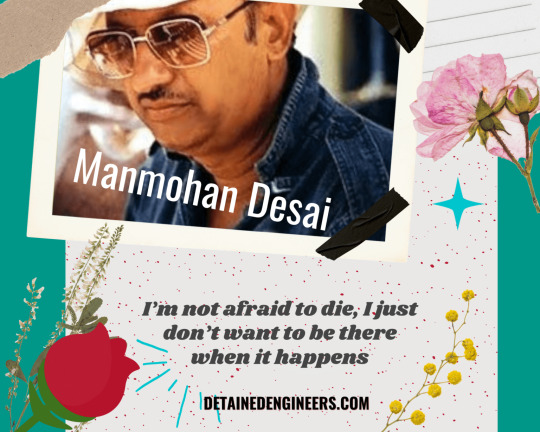
Manmohan Desai was an Indian movie maker and chief who was notable for his family-focused, activity routine movies which took into account the inclinations of the Indian masses and through which he made incredible progress. He was born on February 26, 1937, in Mumbai. His blockbusters movie includes Parvarish, Amar Akbar Anthony, Chacha Bhatija, and Dharam Veer.
The master of family entertainer met his tragic end on March 1st, 1994. The man behind the megastar Amitabh Bachchan’s calling in Bollywood tumbled from the gallery of his home and met his death. It still remains unclear if it was an accident or a suicide. There were assumptions that he took his life as he was not able to cope up with failing health and a declining career. His death also remains in the category of the unsolved deaths in Bollywood.
You Can Read full detail about the Shushant Singh Rajput case: Read More….
1 note
·
View note
Text
SHABNAM: FIRST WOMAN TO BE HANGED IN THE INDEPENDENT INDIA | FIND THE COMPLETE STORY OF THE AMROHA CASE, A BRUTAL CASE OF INHUMANITY.
https://checkbrand.online/viral-trending-blog/news-1/shabnam-first-woman-to-be-hanged-in-the-independent-india-find-the-complete-story-of-the-amroha-case-a-brutal-case-of-inhumanity
0 notes
Text
She killed 7 members of her own family while pregnant. Now her son could be orphaned by execution
Neighbors woke to a woman's cries for help just after 2 a.m. in Bawan Kheri, a village in the northern Indian state of Uttar Pradesh. Sleepily, they emerged from their homes to find a horrific scene of mass murder.Lateef Ullah Khan, one of the first to arrive at the two-story family home on April 15, 2008, found villager Shabnam lying unconscious on the floor near her father, Shaukat Ali, whose his neck was slashed.The bodies of Shabnam's two brothers, her mother, sister-in-law and 14-year-old cousin lay almost beheaded in a blood-splattered room, court documents showed. Her baby nephew, who they would later discover had been strangled to death, appeared to be asleep between his parents' bodies.The case hit headlines -- not only had Shabnam murdered seven of her family members, including a 10-month old child, but she was eight weeks pregnant at the time. Shabnam and her lover, Saleem, were found guilty of the murders and sentenced to hang.If she is executed, Shabnam -- who, like Saleem, is only referred to in court documents by one name -- will be first woman given the death penalty in India since 1955.But with her execution looming, Shabnam's legal team is trying to halt it -- and is arguing that she is a victim, too. Lawyer Shreya Rastogi says her client, who has never admitted to the crime, is a casualty of a patriarchal society that puts caste above all else.เกมคาสิโน
0 notes
Link

0 notes
Text
Shabnam - first woman to be hanged in independent India. Here's the story of her horrific crime
Shabnam – first woman to be hanged in independent India. Here's the story of her horrific crime
Image Source : REPRESENTATIONAL PIC Shabnam – first woman to be hanged in independent India. Here’s the story of her horrific crime For the first time in the history of India’s Independence, a woman on death row will be executed at the country’s lone female execution room in Mathura. According to multiple media reports, Shabnam, one of the two convicts in the sensational Amroha murder case, will…

View On WordPress
0 notes
Text
Shabnam - first woman to be hanged in independent India. Here's the story of her horrific crime
Shabnam – first woman to be hanged in independent India. Here’s the story of her horrific crime
Image Source : REPRESENTATIONAL PIC Shabnam – first woman to be hanged in independent India. Here’s the story of her horrific crime For the first time in the history of India’s Independence, a woman on death row will be executed at the country’s lone female execution room in Mathura. According to multiple media reports, Shabnam, one of the two convicts in the sensational Amroha murder case, will…

View On WordPress
0 notes
Text
Shabnam - first woman to be hanged in independent India. Here's the story of her horrific crime
Shabnam – first woman to be hanged in independent India. Here’s the story of her horrific crime
Image Source : REPRESENTATIONAL PIC Shabnam – first woman to be hanged in independent India. Here’s the story of her horrific crime For the first time in the history of India’s Independence, a woman on death row will be executed at the country’s lone female execution room in Mathura. According to multiple media reports, Shabnam, one of the two convicts in the sensational Amroha murder case, will…

View On WordPress
0 notes
Text
Thoughts on Barsaat Ki Raat
Ngl after reading Noor’s comment “EW GOD NO BHARAT. But every single song is a home run soooo…” (find it here along with other Madhubala movie suggestions), I was intrigued to watch it.
It starts off ok, although the first time they meet is really weird. Surely I’m not the only one who thinks he was so creepy? I mean Shabnam (Madhubala) couldn’t even wait for the rain to stop and ran away.

and then after she knew who he was

Girl...
Not to be harsh on Bharat Bhushan, but I thought he was bland. While his tragic artist act worked in Baiju Bawra, here it just fell flat. I would’ve been A LOT more invested in the love story had another more charismatic actor played the role. The attire and poetry can’t hide the fact that he had nearly one expression throughout the whole movie.

There isn’t much happening in the story. I was excited to see K.N Singh as the angry father but sadly he didn’t do much! Things just fizzled out and ended fast.
Here’s what makes Barsaat ki Raat watchable though :
The three actresses, especially Shyama (Shama) and Ratna Bhushan (Shabab) as the qawwal’s daughters. They work so well together, you can’t even take your eyes off them during the songs. I loved Shabab’s sass, it made her stand out among the more reserved ladies. I don’t particularly agree that the female characters are strong, considering the fact that Shabnam spent the second half of the film moping.

The music by Roshan. I love qawwalis and the three that were featured in are exquisite. Nigah-e-Naaz Ke Maron Ka Haal Kya Hoga is my favourite so far.
The lyrics by Sahir Ludhianvi. I don’t necessarily mind if the songs aren’t translated, but the subtitles are essential in this case. The lyrics contribute so much to the songs, they won’t be as meaningful in my opinion.
Overall it’s a decent watch, if you can handle the rather lukewarm hero and just enjoy the music and actresses.
You can watch Barsaat ki Raat here. Unfortunately, there are no subtitles for the songs (Can’t find the version I downloaded ages ago). However, I have found the Qawwali songs subtitled here : 1-2-3-4.
#madhubala#shyama#old bollywood#hindi cinema#barsaat ki raat#thoughts#barsaat ki raat thoughts#added a cut in case someone doesn't want to spoil it much :)#not that there were many spoilers i think?
17 notes
·
View notes
Text
Chhapaak: As Deepika Padukone champions their cause, meet real life acid attack survivors - bollywood

Muzzafarnagar’s Rupa faced the acid attack inside her own home – her step mother-in-law attacked her and even her father did not stand with her or save her. Deepika Padukone’s latest release Chhapaak salutes the spirit of those like Rupa who fight all odds with little support and emerge winners, even after having faced acid attacks. Directed by Meghna Gulzar, Chhapaak is the story of acid attack survivor Malti (essayed by Deepika) who reclaims her life. Chhapaak is loosely based on Delhi’s Laxmi Aggarwal and also features Vikrant Massey. We profile few of those champions who not only braved the social stigma in a comparatively less-privileged environment of our smaller towns and cities. Also read: Joker star Joaquin Phoenix arrested in climate change protest in Washington Rupa was attacked in 2005 and has been associated with groups supporting and helping women who have faced similar attacks. “I only had my uncle for support. He stood with me throughout,” Rupa says. After staying inside the house for almost nine years, covering her face even from her own family members, Rupa found support in a group of women and began stepping out. She is now an independent woman, earning for herself and takes pride in her face. “I have realised this is my identity now. I am not ashamed of my face anymore,” she says. Lucknow’s Mehrunnisa was in college when a neighbour attacked her with an entire bottle of acid. “He used to follow me and I had complained about him to my family who scolded him. One day, he just came close to me and threw the acid on me. I had near-fatal injuries. Because of the society’s attitude towards women like us, I did not come out of my house for long,” she says. She is now working with Sheroes Café in Agra and credits the NGO with instilling confidence in her. Anmol’s case is even different as she was just two-month-old when acid was thrown on her. Her father attacked her mom and the acid also destroyed her face, giving her major injuries. Anmol says that someone brought her to a hospital and her mother succumbed to the injuries while she kept fighting for five years in the hospital. Anmol does not know who her parents or family are. “But I have been lucky, all the hospital staff took care and ensured I was treated well till the age of five. It was only later that I was sent to an orphanage because they felt I could make a better life for myself if I study,” Anmol says. Aged 19, she calls herself a social media influencer who earns her living through brand associations and content creation for platforms like Instagram and Likee. Anmol, however, is not your conventional social media star – she is an acid attack survivor who also had to struggle with poverty and a lack of home. Anmol started an NGO to help acid attack survivors get proper treatment but left the organisation soon. “Many people got associated with it and began treating it as business. The cost of surgery for acid attack survivors is such that if you remove 20%-30% from the donations, there is practically nothing left. I could not continue with such mentality,” she tells HT. Shabnam, who hails from Agra and works at the Sheroes Café, says she cried a lot while watching Chhapaak. More than her own plight, she was reminded of the hardships that her family faced due to the attack on her. “I feel bad that they had to see such days because of me. Had I not been in that family, they would have never faced all these things.” She worked with a contractor and did embroidery work for him and he attacked her after she did not reciprocate his advances. Reminded that the attacker is to be blamed, not her, Shabnam says, “I know, my parents keep telling me. After I came to Sheroes, I began coming out in the open. Earlier, even if I stepped out, I would cover my face. Now I do not care for what people say and simply do all that I want.” Follow @htshowbiz for more Interact with the author @swetakaushal Read the full article
#$5entertainmentbook#$5entertainmentcouponbook#0151entertainment#08.05entertainment#1entertainmentbedford#1entertainmentbouncycastle#1entertainmentdj#1entertainmentevents#1entertainmentinc#1entertainmentltd#1entertainmentmusicandmanagementgroup#1entertainmentpass#1entertainmentreviews#1entertainmentsittingbourne#2entertainmentmanagementltd#2entertainmentnews#2/0entertainmentcable#3artsentertainment#3ballentertainment#3entertainmentproducts#4entertainmentawards#4entertainmentcreditcard#4entertainmentgroup#4entertainmentgroupllc#4entertainmentgrouplosangeles#4entertainmentjobs#4entertainmentlogo#5entertainmentab#5entertainmentcenter#5entertainmentcompanies
0 notes
Text
Imagination exercise reveals COVID risk of local activities
Combining local and very real risk statistics for COVID-19 infection with an imagination exercise helped participants in a psychology study make more realistic decisions about their own risky behaviors, according to two new papers.
Study participants from all over the country who had dismissed their risks of COVID-19 and those who had perhaps over-responded to the danger both rethought their personal decisions after going through the imagination exercise. Three weeks later, their attitude adjustments still held.
The experimental intervention is now being integrated into a publicly accessible data dashboard through a collaboration between the Duke University research team and scientists at Georgia Institute of Technology. The project has funding from the Centers for Disease Control and Prevention to see if it could help more people properly calibrate their risks and behaviors during the pandemic.
The studies, which appear this week in the Proceedings of the National Academy of Sciences and in Nature Aging, drew on established science about memory and decision-making.
The researchers sought to design an intervention that would help people more accurately gauge the risks they face from the COVID virus while engaging in their typical local activities, such as going to the gym or getting their hair cut.
“We started with this idea that it’s important to have an accurate understanding of risk in our own local communities,” says Allie Sinclair, a graduate student in psychology and neuroscience at Duke, who led the research. “Underestimating risk is of course bad for public health because we can do risky things and put ourselves and others in danger. But at the same time, overestimating risk is not good either,” because curling up in a ball at home can be hard on one’s mental health and financial well-being.
The researchers started the experiment by asking 300 American study participants—who were recruited and tested over the internet—to gauge the local risks they faced doing 15 potentially risky everyday activities like grocery shopping or getting a haircut during the pandemic. In general, their perceptions were not in line with their local statistics, and their attitudes toward the local risks tracked closely with how well they were following public health guidance.
The imagination exercise
In a second study, the psychologists tried to change the way a different group of 735 Americans felt about their real risks.
The first part of this intervention was called the imagination exercise. A quarter of participants were asked to imagine hosting a dinner party in their home with their friends and family and to name the people who would be there. During the party, somebody coughs at the table, and then three days later is found to be positive for COVID-19. The host would then have to call all of the dinner party guests and tell them to get tested.
“By using real people you know in the imagination exercise, it’s designed to make you imagine what it would be like to experience the bad outcome of a risky decision,” Sinclair says.
Another quarter of participants faced the same scenario, but happening to an imagined stranger and their friends. The third condition was a story about a family of rabbits eating some produce that had gone a bit bad and feeling ill afterwards. The fourth condition was a control group without an imagination exercise.
After the imagination exercise, participants were asked to guess the probability (from 0%, impossible to 100%, definitely) of encountering a COVID-positive person in a hypothetical group of people from their area. They guessed the risk probabilities for group sizes ranging from 5 to 500 people.
Using up-to-the-minute county-level COVID-19 statistics, the researchers then gave participants feedback on whether they had been over-estimating or under-estimating their risks of these activities.
After finishing the imagination exercise and the risk guessing game, the participants again reported their attitudes about the riskiness of the 15 everyday activities (such as dining inside a restaurant or exercising at a gym). The intervention worked: Those who overestimated their risks thought better of 12 of the 15 activities; those who underestimated their risks were more wary of the 15 activities—though grocery shopping was apparently non-negotiable.
The group that imagined scenarios about real people had the most lasting attitude change when measured one to three weeks later.
“What do these risk numbers actually mean right now?” says Shabnam Hakimi, who co-led the project with Sinclair during a postdoctoral fellowship at Duke. “You can make it stick with context and personally relevant information.”
So many choices
The study was “kind of an intense version of many of the decisions we face, that are applicable to any kind of choice you make,” Hakimi says. The intervention’s design is related to research by Duke professors Alison Adcock, Gregory Samanez-Larkin, and Roberto Cabeza on motivational states in the brain that make it easier for people of all ages to learn and remember.
“This is a great example of how discoveries we make while trying to understand the basic workings of the human brain can give us new tools to help us live better lives,” says coauthor Alison Adcock, associate professor of psychiatry and behavioral sciences and director of Duke’s Center for Cognitive Neuroscience. “Even for problems that might—at first glance—seem unrelated to the specific scientific questions we start from.”
Stats are better with context
In a companion paper appearing in Nature Aging, the researchers single out one group of participants, the older people, who responded even better to the personal intervention than other subjects. “Aging adults think about positive information differently and value personal scenarios more,” Hakimi says. “And that’s exactly what we found.”
Older people tend to put even more stock in their relationships and friendships, and it’s quite possible that the exercise of imagining the people they know come to harm was even more persuasive for this group, Hakimi says.
“The personalized imagination exercise worked better than just hearing the numerical statistics for older people,” says coauthor Gregory Samanez-Larkin, associate professor of psychology and neuroscience. “This highlights the importance of tailoring public health messages to specific audiences.”
“Right now, the approach typically involves giving people statistics about case numbers and things like that without contextualizing it,” Sinclair says. “And we think that’s kind of doing it a disservice because we’re not giving people enough information to understand how it actually applies to their own lives.”
“If we pair the numerical risk information with that context created by the imagination exercise, we think that will be more effective to help people understand risk and think about how it applies to their own lives,” Sinclair says.
“This research suggests that we need to better humanize data dashboards,” says Samanez-Larkin.
“It’s not about telling them what to do, it’s about giving them the tools to decide what to do,” Hakimi says.
The US National Institute on Aging, the National Science Foundation, and the National Sciences and Engineering Research Council of Canada.
Source: Duke University
The post Imagination exercise reveals COVID risk of local activities appeared first on Futurity.
Imagination exercise reveals COVID risk of local activities published first on https://triviaqaweb.weebly.com/
0 notes
Link
0 notes